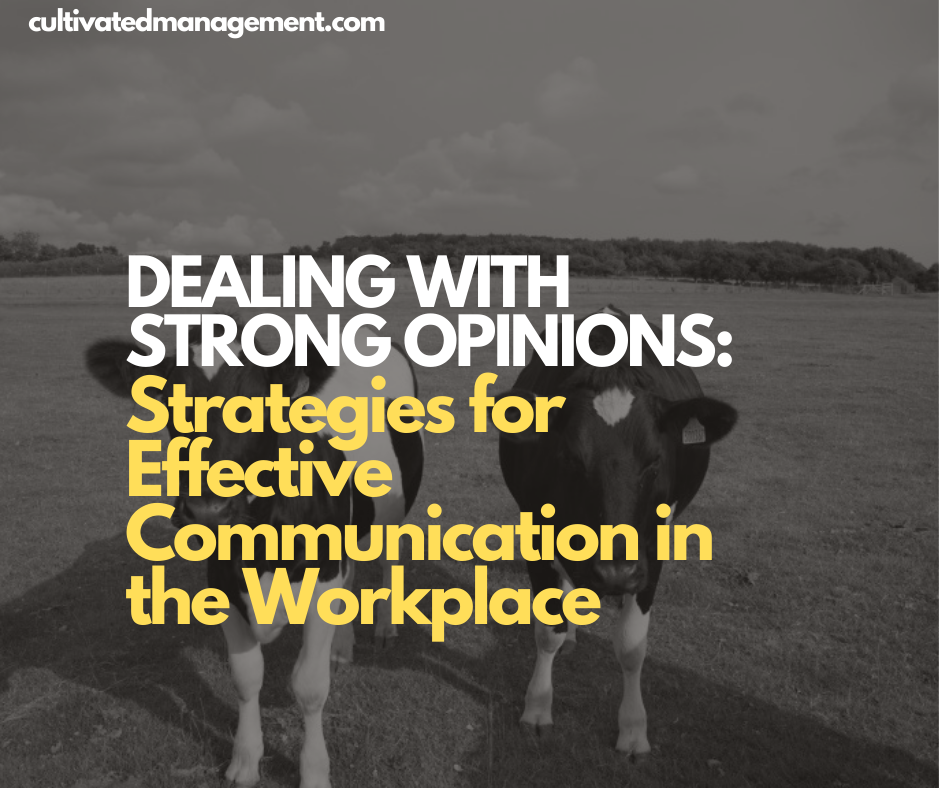
How to Deal with People Who Have Strong Opinions
I was recently working with a client who was struggling to manage a group of consultants with very strong opinions about management and agility. You know the type: they’ve either learned only one way of doing things, or they’re so convinced their approach is the only valid one that every other method is wrong. In this case, they weren’t just convinced—they were literally shouting down anyone who dared to disagree.
Working with people like this can be exhausting. Their opinions are immovable, and their delivery is aggressive. But there is a method to handle them effectively—without losing your composure or your sanity.
Here’s the approach I’ve developed over years of experience. It’s practical, actionable, and—most importantly—effective.

Step 1: Truly Listen
The first and most important step is to listen. Truly listen.
When someone is aggressive, insulting, or dominating, your first instinct might be to defend yourself, shut down, or push back. That’s natural. But it rarely helps. Instead, focus on identifying their core point.
- What is the main idea they’re trying to communicate?
- What problem are they trying to solve?
- What assumptions are they making?
Listening shows respect. Everyone deserves respect, at least at the start. Even if their delivery is abrasive, understanding their perspective is essential.
There’s another benefit: by listening, you may discover new insights or find yourself reconsidering parts of your own thinking. Sometimes, we are too attached to our own opinions to see the value in another perspective—but when we slow down and listen, learning happens.
Step 2: Don’t Take It Personally
This is a skill worth practicing. Other people’s strong opinions are rarely about you.
Consider the reasons behind aggressive or rigid viewpoints:
- Poor communication skills.
- Insecurity about the task or topic at hand.
- A narrow toolkit of methods or processes.
- Confidence or arrogance masking fear.
Most of the time, these opinions reflect something internal—not you.
If the words are personally hurtful, pause. Take a breath and think: “What must be going on in their life to make them say that?” Often, this simple mental reframing helps you detach emotionally and respond rationally.
Step 3: Appreciate That They Are Not Wrong
Even if you think their approach is flawed, you must recognize that their beliefs are real and meaningful to them.
- Long-held beliefs are rarely changed by argument or confrontation.
- Trying to “win” against someone’s belief often escalates conflict instead of resolving it.
Instead, separate beliefs from their delivery of it. You might disagree with what they are saying, but everyone has the right to believe what they believe. Respecting their belief is different from agreeing with it.
Step 4: Learn Their Argument Better Than They Do
If you decide to challenge an opinion, the first step is to understand it better than the person presenting it.
- Study their perspective.
- Ask clarifying questions.
- Identify the assumptions they’re making.
The worst mistake is to push your views without fully understanding theirs. When beliefs collide, arguments rarely lead to clarity.
Questions are powerful tools. They can:
- Help you understand their perspective.
- Encourage them to reconsider their own assumptions.
Some disagreements are productive, especially about methods, tools, or processes—but only if both parties are open to learning.
Step 5: Accept That Other Ways Work
One of the most useful realizations in professional life is that your approach is not the only one that works.
Other methods may be successful in other organizations—or even within your own company.
By listening and understanding first, you can evaluate whether their approach has merit. Sometimes, it’s worth adopting elements of their method. Sometimes, you’ll decide it’s not appropriate. But understanding first prevents premature judgment and wasted energy.
Step 6: Ignore When Necessary
Not every battle is worth fighting. Some opinions, while strong, have little impact on business outcomes or your sphere of influence.
- If someone is outside your authority or influence, ignore it.
- If they are a peer, offer feedback and move on.
- If they are a direct report, provide constructive feedback or coaching.
Preserve your energy for what truly matters. You can’t control anyone, and attempting to do so is exhausting.
Step 7: Communicate With Clarity and Kindness
Strong opinions are often neutralized by superior communication.
- Respond calmly and deliberately.
- Focus on the ideas, not the person.
- Ask questions rather than making declarations.
The goal is not always to “win” the argument. The goal is to ensure the business or team moves forward effectively. Sometimes, their opinion is correct. Sometimes it’s not. Either way, clear and kind communication helps maintain professionalism and fosters understanding.
Step 8: Don’t Be Like Them
Finally, rise above the noise.
- Fight for what matters, but do so with empathy and clarity.
- Avoid mirror aggression—don’t fight fire with fire.
- Responding with patience and logic is more powerful than shouting.
Opinionated people will always argue. You don’t need to join the chorus. Hold your opinions loosely. Fight when necessary. Let go when appropriate.
Practical Techniques for Handling Strong Opinions
Here are actionable strategies you can implement immediately:
- Restate their point back to them. This shows understanding and forces them to clarify.
- Ask open-ended questions. For example: “How has that approach worked in your experience?”
- Separate the idea from the person. Focus on the concept, not the person delivering it.
- Use silence strategically. Pausing can defuse tension and prevent emotional escalation.
- Keep a decision log. Document decisions and rationales. This reduces repeated arguments.
- Pick your battles. Not every opinion deserves energy; focus on high-impact areas.
Why This Works
Listening, detachment, and measured response aren’t just polite—they’re strategic.
- They reduce conflict.
- They increase learning.
- They position you as a professional who handles strong personalities gracefully.
People with strong opinions may never fully change, but by managing your reactions, you maintain control and influence.
A Real-Life Example
I worked with a consultant who insisted on one rigid method for agile transformation. He shouted over every other team member and dismissed alternative approaches.
Here’s what I did:
- I listened first, mapping out his points.
- I asked questions about outcomes, assumptions, and risks.
- I acknowledged valid points he made.
- I calmly presented alternative approaches, supported by data and examples.
The outcome? He didn’t fully agree, but the team started experimenting with hybrid approaches. Conflict decreased, and productivity improved. By managing my response, I influenced the result without confrontation.
Key Takeaways
- Listen first. Identify the core point.
- Detach personally. Most opinions aren’t about you.
- Respect beliefs. Disagree without disrespect.
- Learn the argument. Understand it fully before challenging.
- Other ways work. Stay open to alternatives.
- Ignore wisely. Save energy for what matters.
- Communicate clearly. Focus on ideas, not personalities.
- Rise above. Don’t mirror aggression; fight with logic and empathy.
Dealing with strong opinions is a skill. It takes patience, empathy, and clarity. The more you practice, the better you become—not just at handling others, but at holding your ground gracefully.
At the end of the day, opinionated people will argue. Your role isn’t to match them—it’s to lead by example, communicate effectively, and drive better outcomes. I overheard this quote somewhere – sums it up nicely:
"Opinionated people go around annoying other people with strong opinions"
Remember: you don’t always need an opinion. Sometimes, the most powerful stance is to listen, understand, and choose your battles wisely.
👉 Ready to move faster towards your business goals while building a workplace people love? I help managers and leaders get there—through coaching, consulting, and training. See how I can help you.
